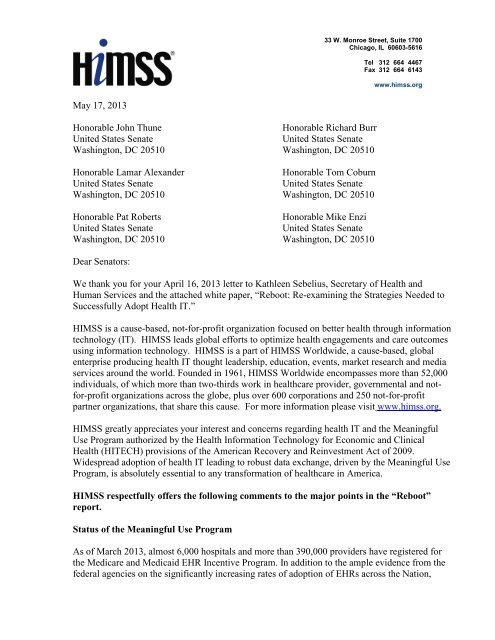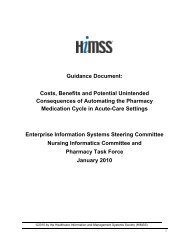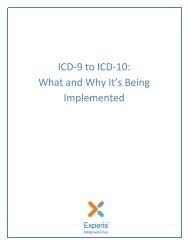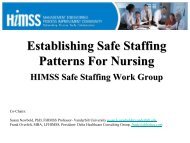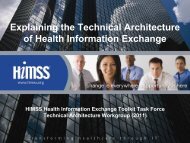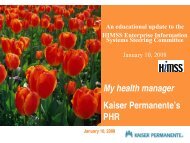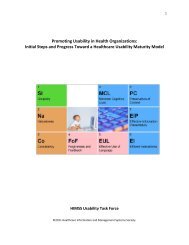REBOOT: Re-examining the Strategies Needed to ... - himss
REBOOT: Re-examining the Strategies Needed to ... - himss
REBOOT: Re-examining the Strategies Needed to ... - himss
You also want an ePaper? Increase the reach of your titles
YUMPU automatically turns print PDFs into web optimized ePapers that Google loves.
33 W. Monroe Street, Suite 1700<br />
Chicago, IL 60603-5616<br />
Tel 312 664 4467<br />
Fax 312 664 6143<br />
www.<strong>himss</strong>.org<br />
May 17, 2013<br />
Honorable John Thune<br />
United States Senate<br />
Washing<strong>to</strong>n, DC 20510<br />
Honorable Lamar Alexander<br />
United States Senate<br />
Washing<strong>to</strong>n, DC 20510<br />
Honorable Pat Roberts<br />
United States Senate<br />
Washing<strong>to</strong>n, DC 20510<br />
Honorable Richard Burr<br />
United States Senate<br />
Washing<strong>to</strong>n, DC 20510<br />
Honorable Tom Coburn<br />
United States Senate<br />
Washing<strong>to</strong>n, DC 20510<br />
Honorable Mike Enzi<br />
United States Senate<br />
Washing<strong>to</strong>n, DC 20510<br />
Dear Sena<strong>to</strong>rs:<br />
We thank you for your April 16, 2013 letter <strong>to</strong> Kathleen Sebelius, Secretary of Health and<br />
Human Services and <strong>the</strong> attached white paper, “<strong>Re</strong>boot: <strong>Re</strong>-<strong>examining</strong> <strong>the</strong> <strong>Strategies</strong> <strong>Needed</strong> <strong>to</strong><br />
Successfully Adopt Health IT.”<br />
HIMSS is a cause-based, not-for-profit organization focused on better health through information<br />
technology (IT). HIMSS leads global efforts <strong>to</strong> optimize health engagements and care outcomes<br />
using information technology. HIMSS is a part of HIMSS Worldwide, a cause-based, global<br />
enterprise producing health IT thought leadership, education, events, market research and media<br />
services around <strong>the</strong> world. Founded in 1961, HIMSS Worldwide encompasses more than 52,000<br />
individuals, of which more than two-thirds work in healthcare provider, governmental and notfor-profit<br />
organizations across <strong>the</strong> globe, plus over 600 corporations and 250 not-for-profit<br />
partner organizations, that share this cause. For more information please visit www.<strong>himss</strong>.org.<br />
HIMSS greatly appreciates your interest and concerns regarding health IT and <strong>the</strong> Meaningful<br />
Use Program authorized by <strong>the</strong> Health Information Technology for Economic and Clinical<br />
Health (HITECH) provisions of <strong>the</strong> American <strong>Re</strong>covery and <strong>Re</strong>investment Act of 2009.<br />
Widespread adoption of health IT leading <strong>to</strong> robust data exchange, driven by <strong>the</strong> Meaningful Use<br />
Program, is absolutely essential <strong>to</strong> any transformation of healthcare in America.<br />
HIMSS respectfully offers <strong>the</strong> following comments <strong>to</strong> <strong>the</strong> major points in <strong>the</strong> “<strong>Re</strong>boot”<br />
report.<br />
Status of <strong>the</strong> Meaningful Use Program<br />
As of March 2013, almost 6,000 hospitals and more than 390,000 providers have registered for<br />
<strong>the</strong> Medicare and Medicaid EHR Incentive Program. In addition <strong>to</strong> <strong>the</strong> ample evidence from <strong>the</strong><br />
federal agencies on <strong>the</strong> significantly increasing rates of adoption of EHRs across <strong>the</strong> Nation,
HIMSS Letter <strong>to</strong> Sena<strong>to</strong>rs Thune, Alexander, Roberts, Burr, Coburn, and Enzi May 2013<br />
HIMSS Analytics’ data shows that Meaningful Use is definitely and positively affecting EHR<br />
adoption in this country. 1<br />
In 2006, HIMSS released <strong>the</strong> HIMSS Analytics’ Electronic Medical <strong>Re</strong>cord Adoption Model<br />
(EMRAM SM ) <strong>to</strong> demonstrate a maturing IT adoption model at all civilian hospitals and<br />
healthcare systems in <strong>the</strong> U.S. Since that time, <strong>the</strong> EMRAM has become <strong>the</strong> standard <strong>to</strong> measure<br />
acute care hospitals’ adoption of health IT. The facility-level data is collected by HIMSS<br />
Analytics with <strong>the</strong> cooperation of <strong>the</strong> individual facilities.<br />
Based on our analysis, beginning with <strong>the</strong> first EHR Incentive Program payments in May 2011,<br />
<strong>the</strong> number of U.S. acute care hospitals achieving EMRAM Stage 5 or Stage 6 has increased by<br />
more than 80% for each stage. The number of Stage 7 hospitals has increased 63%. The<br />
corresponding data for lower end stages has seen decreases of 16% <strong>to</strong> 35%.<br />
EMRAM Stage 6 or Stage 7 corresponds with preparedness <strong>to</strong> share data with o<strong>the</strong>r healthcare<br />
entities. EMRAM score trending tells us that U.S. hospitals are moving in <strong>the</strong> right direction <strong>to</strong><br />
support information sharing necessary for care coordination that supports healthcare<br />
transformation.<br />
The next challenge becomes incentivizing data sharing with o<strong>the</strong>r entities. To address <strong>the</strong><br />
expected challenge, HIMSS’ Public Policy Principles call for <strong>the</strong> federal government <strong>to</strong> shift <strong>the</strong><br />
emphasis from <strong>the</strong> prescriptive models of Meaningful Use Stages 1 and 2 <strong>to</strong> a model that<br />
encourages and teaches providers <strong>to</strong> take advantage of <strong>the</strong> capabilities inherent in health IT<br />
solutions, including interoperability.<br />
To support this transition, HIMSS is establishing a Clinical & Business Intelligence Model with<br />
<strong>the</strong> intention of providing practical examples of how data collection and analysis can help<br />
providers both in <strong>the</strong> ambula<strong>to</strong>ry and acute settings improve clinical outcomes and business<br />
efficiencies. The model will be evolving over <strong>the</strong> course of 2013. We look forward <strong>to</strong> <strong>the</strong><br />
opportunity <strong>to</strong> brief you on this important <strong>to</strong>ol for <strong>the</strong> healthcare community.<br />
Path Toward Interoperability<br />
The healthcare community has a strong his<strong>to</strong>ry of working <strong>to</strong>ge<strong>the</strong>r <strong>to</strong> identify and develop<br />
standards and implementation specifications that will support interoperability leading <strong>to</strong><br />
information exchange. National and international efforts like <strong>the</strong> Integrating <strong>the</strong> Healthcare<br />
Enterprise (IHE) Initiative, <strong>the</strong> Health IT Standards Committee, and <strong>the</strong> Office of <strong>the</strong> National<br />
Coordina<strong>to</strong>r for Health IT’s Standards & Interoperability Framework each play a role in our<br />
collective efforts <strong>to</strong> more rapidly advance interoperability.<br />
1 HIMSS Analytics is a wholly owned not-for-profit subsidiary of <strong>the</strong> Healthcare Information and Management<br />
Systems Society. The company collects and analyzes healthcare data related <strong>to</strong> IT processes and environments,<br />
products, health entity information systems department composition and costs, IS department management metrics,<br />
healthcare trends and purchase-related decisions. HIMSS Analytics delivers high quality data and analytical<br />
expertise <strong>to</strong> healthcare delivery organizations, healthcare IT companies, state governments, financial companies,<br />
pharmaceutical companies, and consulting firms. Visit www.<strong>himss</strong>analytics.org for more information.<br />
2
HIMSS Letter <strong>to</strong> Sena<strong>to</strong>rs Thune, Alexander, Roberts, Burr, Coburn, and Enzi May 2013<br />
HIMSS has dedicated a section of our Public Policy Principles <strong>to</strong> Interoperability, Standards, and<br />
Infrastructure. As an organization, we support <strong>the</strong> advancement of interoperable health<br />
information systems, extending well beyond EHRs, <strong>to</strong> address <strong>the</strong> functional needs of <strong>the</strong> full<br />
spectrum of healthcare delivery organizations, population and public health agencies, patients,<br />
and o<strong>the</strong>r healthcare programs. We support ONC’s efforts <strong>to</strong> utilize an open, transparent, multistakeholder<br />
standards harmonization process that encourages vendors <strong>to</strong> build robust<br />
interoperability in<strong>to</strong> <strong>the</strong>ir products, discourages proprietary technology approaches, and supports<br />
facilities’ secure exchange of health information.<br />
In addition, we strongly support a process <strong>to</strong> ensure that all nationally-adopted standards,<br />
implementation specifications, and operating rules are available, well-tested according <strong>to</strong><br />
standard testing methodologies, and deemed proven in <strong>the</strong> field before <strong>the</strong>y are required for<br />
implementation. This can be a difficult challenge, but one that is critical <strong>to</strong> <strong>the</strong> overall success of<br />
interoperability that leads <strong>to</strong> information exchange.<br />
To that end, <strong>the</strong>re are several industry and HIMSS-led initiatives that can help advance <strong>the</strong> cause<br />
of interoperability, including IHE. Established in 1998 with <strong>the</strong> Radiological Society of North<br />
America (RSNA International), IHE is organized in<strong>to</strong> workflow-focused domains such as Patient<br />
Care Coordination, Radiology and Dentistry. Each domain develops consensus, standards-based<br />
specifications called IHE Profiles <strong>to</strong> address needs <strong>to</strong> exchange information <strong>to</strong> deliver care<br />
efficiently and effectively. The IHE Profiles are designed <strong>to</strong> perform such critical functions as<br />
organizing and leveraging <strong>the</strong> integration capabilities <strong>the</strong> can be achieved by coordinated<br />
implementation of communication standards; provide precise definitions of how standards can be<br />
implemented <strong>to</strong> meet specific clinical needs, offer developers a clear implementation path for<br />
communication standards that are accepted industry wide; and give purchasers a <strong>to</strong>ol that reduces<br />
<strong>the</strong> complexity, cost and anxiety of implementing interoperable systems.<br />
IHE conducts annual Connectathons <strong>to</strong> provide opportunities for product developers <strong>to</strong> test and<br />
demonstrate <strong>the</strong>ir products’ capabilities <strong>to</strong> share data with o<strong>the</strong>r IHE compliant products in<br />
specific, real world scenarios. The products that demonstrate success at <strong>the</strong> Connectathons are<br />
invited <strong>to</strong> participate in Interoperability Showcases at HIMSS’ Annual Conference, as well as <strong>the</strong><br />
American College of Cardiology and RSNA annual meetings.<br />
Interoperability testing is a critical component of future success of health IT solutions. In<br />
Oc<strong>to</strong>ber 2013, HIMSS is launching <strong>the</strong> HIMSS Innovation Center in Cleveland Ohio as part of<br />
<strong>the</strong> Global Center for Health Innovation. The HIMSS Innovation Center is a permanent<br />
demonstration and testing facility serving as a global resource where health solutions providers<br />
can work side by side with o<strong>the</strong>r state-of-<strong>the</strong>-art technology organizations on major initiatives<br />
including mobile health, consumer-driven health, accountable care, and coordinated care. The<br />
Innovation Center will be <strong>the</strong> first collaborative environment open year-round in which all<br />
healthcare stakeholders can work <strong>to</strong>ge<strong>the</strong>r <strong>to</strong> evolve <strong>the</strong> interoperability capabilities needed <strong>to</strong><br />
improve healthcare.<br />
3
HIMSS Letter <strong>to</strong> Sena<strong>to</strong>rs Thune, Alexander, Roberts, Burr, Coburn, and Enzi May 2013<br />
Increased Healthcare Costs Attributable <strong>to</strong> Electronic Health <strong>Re</strong>cords<br />
In Section II of “<strong>Re</strong>boot”, you raised concerns that <strong>the</strong> “Misuse of EHRs May Actually Increase<br />
Health Care Costs.” HIMSS’ statement for <strong>the</strong> May 3, 2013 CMS-ONC Listening Session on<br />
Billing and Coding with EHRs addressed <strong>the</strong> concern that EHRs contribute <strong>to</strong> increased costs.<br />
Providers have always worried about claims of fraud and abuse. Many anecdotally report that,<br />
attempting <strong>to</strong> select correct codes from complex billing guidelines in <strong>the</strong> years prior <strong>to</strong><br />
widespread use of EHRs, <strong>the</strong>y would under code for patient encounters if <strong>the</strong>y were unsure.<br />
Coincident with many o<strong>the</strong>r beneficial functions, <strong>to</strong>day’s EHR systems can facilitate better<br />
documentation as well as <strong>the</strong> direct selection of diagnosis and procedure codes by providers, as<br />
well as a capability for computer-assisted coding. Health IT enables earlier recognition of<br />
potential medical problems. Such problems can be addressed in early stages through follow-ups<br />
and preventive/screening tests. While <strong>the</strong>se efforts may increase short-term costs, <strong>the</strong>re exists a<br />
potential long-term benefit of decreased costs as we aim for a healthier population, improve<br />
chronic disease management, and avoid later-stage high care costs by treating conditions at an<br />
earlier stage.<br />
There are still challenges, particularly with Evaluation and Management Codes, functionality and<br />
systems usability. HIMSS supports billing compliance efforts that enable improvements in<br />
documentation that support both patient care and medical necessity determinations. These<br />
functions must be performed in an accurate and compliant manner.<br />
To that end, HIMSS supports <strong>the</strong> development of clear documentation guidelines <strong>to</strong> protect<br />
healthcare program integrity, while educating providers <strong>to</strong> ensure <strong>the</strong>y are not penalized or<br />
subject <strong>to</strong> undue fraud allegations for simply utilizing technology <strong>to</strong> improve clinical<br />
documentation.<br />
HIMSS is actively engaged with <strong>the</strong> federal government and o<strong>the</strong>r healthcare organizations <strong>to</strong><br />
address billing and coding challenges <strong>to</strong> ensure providers optimize <strong>the</strong> use of EHRs <strong>to</strong> improve<br />
<strong>the</strong> quality and cost effectiveness of care delivery.<br />
Evaluation and Oversight<br />
HIMSS supports <strong>the</strong> proposal for more formal analyses and progress reviews. We strongly<br />
concur with CMS and ONC decisions <strong>to</strong> defer, for <strong>the</strong> remainder of 2013, fur<strong>the</strong>r rulemaking<br />
related <strong>to</strong> Meaningful Use Stage 3.<br />
In addition, our Public Policy Principles call on CMS and ONC <strong>to</strong> conduct periodic reviews <strong>to</strong><br />
evaluate Meaningful Use and Certification Process requirements <strong>to</strong> analyze <strong>the</strong> benefits and<br />
costs/burdens on providers, vendors, and government. To ensure greater understanding and<br />
compliance with <strong>the</strong> Meaningful Use program, we encourage <strong>the</strong> Secretary and <strong>the</strong> Department<br />
of Health and Human Services <strong>to</strong> maintain a clear process for interpreting Meaningful Use rules<br />
that goes beyond reliance on Frequently Asked Questions and o<strong>the</strong>r sub-regula<strong>to</strong>ry processes.<br />
Streamlining <strong>the</strong> regula<strong>to</strong>ry process and making timely and appropriate edits <strong>to</strong> <strong>the</strong> regulations<br />
will help ensure program compliance.<br />
4
HIMSS Letter <strong>to</strong> Sena<strong>to</strong>rs Thune, Alexander, Roberts, Burr, Coburn, and Enzi May 2013<br />
Finally, we encourage Congress <strong>to</strong> exercise oversight authority by engaging <strong>the</strong> Government<br />
Accountability Office and conducting bipartisan hearings on progress <strong>to</strong>ward meeting <strong>the</strong> goals<br />
of HITECH.<br />
Patient Privacy and Safety at Risk<br />
Our collective focus must be on improving <strong>the</strong> quality and safety of care delivery, costeffectiveness,<br />
and ensures easier access <strong>to</strong> care. We can accomplish such improvement by<br />
ensuring <strong>the</strong> value of health IT. To appropriately engage <strong>the</strong> patient as a willing consumer of<br />
<strong>the</strong>se necessary improvements <strong>to</strong> <strong>the</strong> healthcare system, patient safety and protection of personal<br />
health information must be paramount.<br />
With respect <strong>to</strong> patient safety, HIMSS supports <strong>the</strong> promotion and reporting of improvements in<br />
patient safety that are achievable as a result of <strong>the</strong> widespread use of EHR. This must be<br />
simultaneously balanced with encouraging innovation, and with disseminating lessons learned<br />
from unintended consequences associated with technology use. Advancements in technology<br />
associated with clinical decision support, electronic prescriptions, and computerized provider<br />
order entry have an incredible impact on <strong>the</strong> quality of care delivered <strong>to</strong> <strong>the</strong> patient. Utilizing<br />
<strong>the</strong>se <strong>to</strong>ols can improve care delivery. The patient, provider, and o<strong>the</strong>rs in <strong>the</strong> healthcare<br />
community must be educated on <strong>the</strong> proper use of technology <strong>to</strong> ensure care improvements.<br />
To support interoperability that enhances patient safety, HIMSS suggests one of <strong>the</strong> largest<br />
unresolved issues in <strong>the</strong> safe and secure electronic exchange of health information is <strong>the</strong> need for<br />
a nationwide patient data matching strategy <strong>to</strong> ensure <strong>the</strong> accurate, timely, and efficient matching<br />
of patients with <strong>the</strong>ir health data across different systems and settings of care. Such a nationwide<br />
patient data matching strategy does not mean a national identity number or card. Technological<br />
advances now allow for much more sophisticated solutions <strong>to</strong> patient identity and privacy<br />
controls, including patient consent, voluntary patient identifiers, metadata identification tagging,<br />
and access credentialing. We strongly encourage Congress <strong>to</strong> direct an appropriate study <strong>to</strong><br />
develop <strong>the</strong> national strategy in a timely and effective manner.<br />
Privacy and security remain important elements <strong>to</strong> ensure patients trust <strong>the</strong> secure exchange of<br />
<strong>the</strong>ir data. HIMSS strongly supports efforts <strong>to</strong> ensure patients, families, and legal surrogates<br />
have electronic access <strong>to</strong> data. We need <strong>to</strong> balance <strong>the</strong> requirements of essential, appropriate,<br />
and secure information access and exchange without imposing requirements that are technically<br />
or operationally impractical, unreasonably costly, or overly burdensome.<br />
The Value of Healthcare Information Technology<br />
In conclusion, when properly utilized, health IT can be an impactful <strong>to</strong>ol <strong>to</strong> improve care<br />
delivery and care coordination goals. Examples of <strong>the</strong> successful use of health IT is evident in<br />
<strong>the</strong> case studies of HIMSS Nicholas E. Davies Award recipients. These hospitals, clinical<br />
practices, and public health settings are utilizing EHRs and o<strong>the</strong>r health IT solutions <strong>to</strong> improve<br />
<strong>the</strong> quality of life and care delivered for patients and providers in <strong>the</strong>ir communities. The<br />
challenge is ensuring <strong>the</strong>se success s<strong>to</strong>ries are transferable <strong>to</strong> provider settings across <strong>the</strong> U.S.<br />
5
HIMSS Letter <strong>to</strong> Sena<strong>to</strong>rs Thune, Alexander, Roberts, Burr, Coburn, and Enzi May 2013<br />
HIMSS looks forward <strong>to</strong> continuing <strong>the</strong> dialogue between our members and <strong>the</strong> Congress <strong>to</strong><br />
ensure <strong>the</strong> health IT remains <strong>the</strong> transformational force for <strong>the</strong> betterment of health and<br />
healthcare for all Americans. If you have any questions, please contact Richard M. Hodge,<br />
HIMSS Senior Direc<strong>to</strong>r of Congressional Affairs at 703-562-8847.<br />
Sincerely,<br />
Willa Fields, DNSc, RN, FHIMSS<br />
Chair, HIMSS Board of Direc<strong>to</strong>rs<br />
Professor, School of Nursing,<br />
San Diego State University<br />
H. Stephen Lieber, CAE<br />
President/CEO<br />
HIMSS<br />
6


